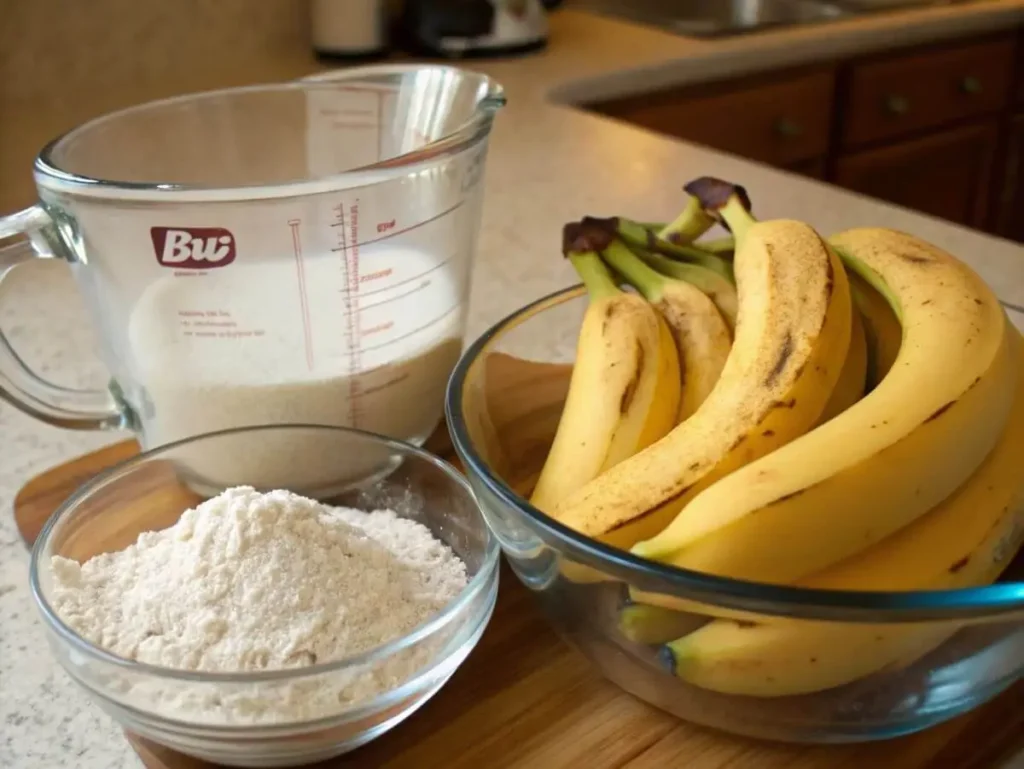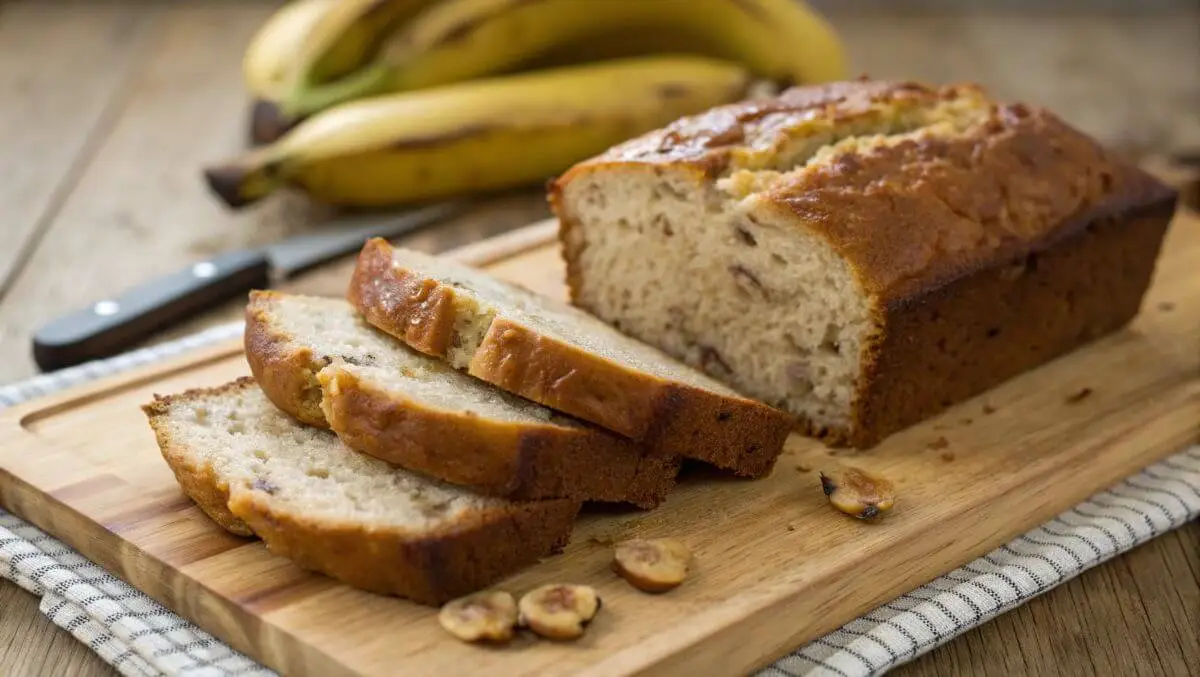Banana bread is a delicious and popular treat enjoyed by many. It’s often seen as a comforting option for breakfast, a snack, or dessert. However, regarding health, you might wonder: is banana bread healthy or unhealthy? This article will explore the nutritional aspects of banana bread, examining its ingredients, benefits, potential downsides, and ways to make it more nutritious. We’ll dive into the specifics of its composition and help you make informed choices. By the end, you will have a clearer idea of how to enjoy banana bread while considering your health.
Understanding Banana Bread
What is Banana Bread?
Banana bread is a baked good made primarily from mashed bananas, flour, sugar, and other ingredients like eggs, baking soda, and butter. Its moist texture and sweet flavor make it a comforting favorite. Banana bread’s origins date back to the 1930s in the United States, and it has since become a staple in many households.
Essential Ingredients Used in Banana Bread
The ingredients used in banana bread play a significant role in determining whether it’s healthy or unhealthy. Here’s a quick rundown of standard components:

- Ripe Bananas: The key ingredient is providing natural sweetness and moisture.
- Flour: Typically, all-purpose flour is used, and its nutritional value can vary depending on the type.
- Sugar: Adds sweetness but can be high in calories, contributing to its overall health profile.
- Egg: Helps bind the ingredients and adds protein.
- Butter or Oil: Adds fat, impacting the texture, flavor, and calorie content.
Understanding these ingredients is crucial to evaluating whether banana bread is healthy or unhealthy. In the following sections, we’ll discuss the nutritional aspects of banana bread further, helping you to evaluate its healthiness.
Nutritional Breakdown of Banana Bread
Caloric Content of Banana Bread
When evaluating whether banana bread is healthy or unhealthy, an essential factor to consider is its caloric content. A typical slice of homemade banana bread contains about 100 to 200 calories, but this can vary based on the ingredients and portion sizes. Store-bought varieties may have added sugars, preservatives, or fats that can significantly increase the calorie count.
In addition, if you add extras like chocolate chips or nuts, the calorie count will rise. While indulging occasionally is okay, being aware of calorie intake helps maintain a balanced diet.
Nutrients Found in Banana Bread
Banana bread offers a variety of nutrients thanks to its main ingredient:
- Fiber: Bananas and whole grain flours contain fiber, which aids digestion and helps you feel full. This can be beneficial when you wonder if banana bread is healthy or unhealthy? as fiber contributes positively to health.
- Vitamins: Bananas are rich in vitamins C and B6. Vitamin C is essential for immunity and skin health, while B6 supports brain function and the formation of neurotransmitters.
- Minerals: Ingredients like nuts (if added) provide healthy fats and essential minerals, such as magnesium and potassium, which are vital for heart health and muscle function.
While banana bread does have its share of nutrients, it’s always best to consider the overall ingredient list to make a well-rounded judgment about its healthiness.
Comparing Homemade vs. Store-Bought Banana Bread
When assessing whether banana bread is healthy or unhealthy, comparing homemade and store-bought options is crucial.
- Homemade Banana Bread: Typically has more control over the ingredients, allowing for healthier substitutes like whole grains or lower sugar levels. This will enable you to customize the recipe to fit your dietary preferences.
- Store-bought banana Bread Often contains preservatives, added sugars, and unhealthy fats that can detract from its nutritional value. It’s usually more convenient but may not be as healthy as homemade versions.
Awareness of these differences allows you to make informed decisions based on convenience and health. Always check ingredient labels when choosing store-bought options!
Health Benefits of Banana Bread
Advantages of Ingredients in Banana Bread
When it comes to whether banana bread is healthy or unhealthy, understanding the advantages of its ingredients is essential. The star of the recipe, ripe bananas, provides natural sweetness without the need for excessive added sugars. They also contribute essential nutrients, making your banana bread a nourishing option.
Additionally, incorporating whole grain flour instead of white flour increases fiber content, which is beneficial for digestive health. Whole grains can help you feel fuller longer and provide sustained energy throughout the day.
Banana Bread as a Source of Energy
Another reason to consider banana bread at work is its usefulness as an energy source. Thanks to the natural sugars in bananas and carbohydrates from flour, it offers a quick energy boost. This makes banana bread a great snack, especially in the afternoon when your energy dips!
Moreover, the combination of carbs and fiber means you won’t experience a quick spike followed by a crash like candy or other sugary snacks. Instead, you’ll enjoy a steady release of energy, keeping you productive and focused.
Fiber Content and Digestive Health
One of the most notable benefits of banana bread, mainly made with whole wheat flour, is its fiber content. Fiber is essential for healthy digestion and can help prevent constipation. Whether banana bread is healthy or unhealthy, remember that fiber also promotes a feeling of fullness.
This can be particularly helpful if you’re mindful of snacking and portion sizes throughout the day. Including fiber-rich foods like banana bread can support digestive health and overall well-being.
In summary, while being aware of the potential downsides is essential, enjoying banana bread has significant health benefits. From energy boosts to nutrient-rich ingredients, it can certainly be in a balanced diet when consumed mindfully.
Potential Downsides of Eating Banana Bread
Sugar and Calorie Concerns
While delicious, one central question remains: is banana bread healthy or unhealthy? One key downside lies in its sugar and calorie content. Traditional banana bread recipes can be high in sugar, contributing to a significant calorie count. The sweetness often comes from the bananas and added sugars, which can lead to excess calorie intake, especially if you enjoy large slices.
Mindful portion control is critical for those managing their weight or blood sugar levels. If you’re concerned about sugar and calorie intake, consider reducing the amount of sugar in the recipe or using natural sweeteners instead.
Impact of Refined Ingredients
Another aspect to think about is the use of refined ingredients. Many banana bread recipes call for all-purpose flour, which lacks the fiber and nutrients of whole grains. Consuming refined carbohydrates can lead to spikes in blood sugar levels, leaving you with less energy after that initial boost.
If you decide to make banana bread as a more frequent treat, consider experimenting with whole grain or oat flour. These options can make the bread healthier while still keeping it delicious.
Allergies and Nutritional Constraints
Lastly, it’s important to note that not everyone can enjoy banana bread due to allergies or dietary restrictions. Common ingredients like nuts, gluten, and dairy can pose challenges for those with allergies or sensitivities.
If you’re serving banana bread at work, check with your coworkers regarding any allergies they may have. Fortunately, many recipes cater to gluten-free, vegan, or nut-free preferences, ensuring everyone can enjoy this classic treat!
In summary, while banana bread can have nutritious benefits, awareness of its downsides helps you make informed choices about its consumption. Consider sugar and calorie counts, the quality of ingredients, and specific dietary needs.
Making Healthier Banana Bread Choices
Substitutes for Healthier Ingredients
If you’re still pondering whether banana bread is healthy or unhealthy? You’ll be pleased to know you can easily make more nutritious choices without sacrificing flavor! Here are some suggestions for swapping out healthier ingredients:
- Whole Wheat Flour: Instead of using all-purpose flour, try whole wheat flour. It adds more fiber and nutrients, resulting in a more wholesome loaf.
- Reduce Sugar: Reduce added sugars by using fewer amounts or substituting with natural sweeteners like honey, maple syrup, or coconut sugar.
- Add Healthy Fats: If using butter, swap half with unsweetened applesauce or Greek yogurt. This helps lower the calorie content while adding moisture.
Portion Control and Moderation
Another important factor when deciding whether banana bread is healthy or unhealthy is portion control. While it’s okay to enjoy this delicious treat, moderation is key. Rather than having large slices, consider cutting smaller pieces, which allows you to enjoy banana bread without overindulging.
To help with portion control, pre-slice the banana bread and store it in serving-sized containers. This makes it easier to grab a single piece when you need a snack and prevents mindless eating.
Tips for Baking a Healthier Banana Bread
When making banana bread at home, keep these tips in mind to make it a healthier option:
- Experiment with Add-Ins: For added health benefits, incorporate nutritious add-ins like chia seeds, flaxseed meal, or rolled oats.
- Choose Ripe, Spotty Bananas: The riper the bananas, the less sugar you’ll need to add since they’ll be naturally sweeter. This helps enhance flavor while reducing added sugars.
By making these adjustments, you can create banana bread that tastes great and contributes positively to your diet. When prepared with healthier ingredients, banana bread can be both a delightful and nutritious experience!
LSI and NLP Keywords Related to Banana Bread Health
Related Keywords in Banana Bread Conversations
When exploring whether banana bread is healthy or unhealthy? Incorporating keywords and phrases related to this topic can provide a more comprehensive understanding. Here are some related terms to consider:
- Nutritional Value of Banana Bread: This term focuses on the vitamins, minerals, and health benefits of banana bread.
- Benefits of Whole Grains: Since many people explore using whole wheat flour in banana bread recipes, understanding the benefits of whole grains becomes valuable.
- Sugar Content in Banana Bread: Monitoring sugar levels is essential, particularly for health-conscious individuals.
- Homemade vs. Store-Bought Banana Bread: Comparing the healthfulness of homemade options to pre-packaged varieties provides insight into making better choices.
Cooking and Storage Techniques Relevant to Banana Bread
Various cooking methods and storage techniques also play a significant role in determining how healthy banana bread can be:
- Baking Techniques: Properly baking banana bread ensures it is moist and flavorful while utilizing healthier ingredients.
- Storage Tips: Understanding how to store banana bread can prevent spoilage and extend its shelf life, allowing for a more responsible consumption pattern.
Using these keywords and phrases throughout your discussions and recipes can create a richer context around banana bread’s health implications. This approach allows you to engage more deeply with the topic while educating yourself and others.
Conclusion: The Health Perspective on Banana Bread
Recap of Key Points
In conclusion, the question is whether banana bread is healthy or unhealthy. Offers a nuanced perspective. While banana bread has benefits, such as providing vitamins, minerals, and potential energy boosts, it can also be high in sugar and calories if made with refined ingredients. Understanding these factors is crucial when deciding whether to enjoy this beloved treat.
Encouragement to Enjoy Banana Bread Mindfully
As with many foods, moderation and mindful eating are key. By making healthier ingredient choices, practicing portion control, and being aware of how long banana bread lasts unrefrigerated, you can savor the joy of banana bread without compromising your health. So go ahead, bake that delicious loaf, and share it with friends and family, all while being conscious of its nutritional impact!


1 thought on “Is banana bread healthy or unhealthy?”